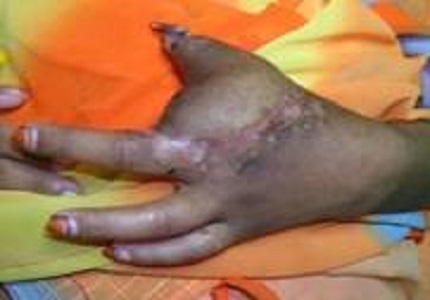Surgical Management of Snake Envenomation in India Current Perspective
Abstract
India has reported one of the highest snake bite mortality rates in the world. It is estimated that over 5 million persons per year are bitten by snakes of whom, over 1,00,000 survivors develop severe sequelae due to local wound complications. The adoption of harmful first aid practices like use of tourniquets or cutting and sucking the snake bite marks further complicates wound management. National Snake Bite Protocol has been issued in 2007, with technical support from WHO to institute proper management of snake bites. However, there is no evidence based guidelines for local wound management in sna ke envenomation. The local tissue problems at the bite site were effectively managed by timely administration of anti-snake venom and other supportive management in majority of patients. Cribari et al have graded the local signs of envenomation. Local tissue complications are most frequently seen with bite from Viperidae. Cytotoxic enzymes in viper venom cause proteolysis, lipolysis, blisters, necrosis and gangrene. Surgical management of snake bite has a significant role in preventing late sequelae and permanent disability due to snake bite wounds. The aim of surgical intervention will be radical removal of all devitalized tissues, followed by reconstructive procedures using skin grafts and flaps, to minimize functional loss and maximize rehabilitation. This paper explores the pathology of a snake bite wound and compiles the accepted guidelines for wound management and also the do’s and don’ts pertaining to the bite areas following a snake bite.
Downloads
References
2. Singh S, Singh G. Snake Bite: Indian Guidelines Protocol, Toxicology 2013 (www.apiindia.org/medicine - update - 2013/Chap.94)
3. Kasturiratne A, Wickremasinghe AR, de Silva N, Gunawardena NK, Pathmeswaran A, Premaratna R, Savioli L, Lalloo DG, de Silva HJ. The global burden of snakebite: a literature analysis and modelling based on regional estimates of envenoming and deaths. PLoS Med. 2008 Nov 4;5(11):e218. doi: 10.1371/journal.pmed.0050218.
4. Anghore D, Sharma A, Singh S et al. Treatment of snake bite in India: A review. IJPTP 2015; 6(4): 2635-2641.
5. David A.Warrel. Guidelines for management of snake bites. WHO Regional Office for South-East Asia, 2010. ISBN 978-92-9022-377-4.
6. Hati AK, Mandal M, De MK, Mukherjee H, Hati RN. Epidemiology of snake bite in the district of Burdwan, West Bengal. J Indian Med Assoc. 1992 Jun;90(6):145-7. [PubMed]
7. Gaitonde BB, Bhattacharya S. An epidemiological survey of snake-bite cases in India. Snake 1980;12:129–33.
8. Punde DP. Management of snake-bite in rural Maharashtra: a 10-year experience. Natl Med J India. 2005 Mar-Apr;18(2):71-5. [PubMed]
9. National Snake bite Management Protocol. Ministry of Health and Family Welfare, Govt. of India, 2009 With Technical Support from WHO. 164.100.130.11: 8091/nationalsnakebitemanagementprotocol.pdf
10. Saini RK, Sharma S, Singh S, Pathania NS. Snake bite poisoning: a preliminary report. J Assoc Physicians India. 1984 Feb;32(2):195-7. [PubMed]
11. Toschlog EA, Bauer CR, Hall EL, Dart RC, Khatri V, Lavonas EJ. Surgical considerations in the management of pit viper snake envenomation. J Am Coll Surg. 2013 Oct;217(4):726-35. doi: 10.1016/j.jamcollsurg.2013.05.004. Epub 2013 Jul 25. [PubMed]
12. Ghosh S, Mukhopadhyay P, Chatterjee T. Management of Snake Bite in India. J Assoc Physicians India. 2016 Aug;64(8):11-14. [PubMed]
13. Jobin A, Rai N. New aspects for treatment of snake bite: a review. IRJP 2012; 3(11): 1-15.
14. Simpson ID, Norris RL. Snakes of Medial Importance in India. Is the concept of the “Big 4” Still relevant and useful? Wilderness Environ Med 2007; 18: 2-9. doi: 10.1186/s13104-015-1426-z. [PubMed]
15. Cribari C. Management of poisonous snake bites. 2004; American College of Surgeons Committee on Trauma. https://www.facs.org/~/media/files/quality%20programs/trauma/.../snakebite.ashx
16. Köse R. [The management of snake envenomation: evaluation of twenty-one snake bite cases]. Ulus Travma Acil Cerrahi Derg. 2007 Oct;13(4):307-12. [PubMed]
17. Mabvuure NT, Malahias M, Hindocha S, Khan W, Juma A. Acute compartment syndrome of the limbs: current concepts and management. Open Orthop J. 2012;6:535-43. doi: 10.2174/1874325001206010535. Epub 2012 Nov 30. [PubMed]
18. Bozkurt M, Kulahci Y, Zor F, Kapi E. The management of pit viper envenomation of the hand. Hand (N Y). 2008 Dec;3(4):324-31. doi: 10.1007/s11552-008-9114-2. Epub 2008 May 28. [PubMed]
19. Malahias M, Jordan D, Hughes O, Khan WS, Hindocha S. Bite injuries to the hand: microbiology, virology and management. Open Orthop J. 2014 Jun 27;8:157-61. doi: 10.2174/1874325001408010157. eCollection 2014. [PubMed]
20. Gras S, Ptantefeve G, Band F, Crippaux JA. Snake bite on the hand : Lessons from two clinical cases illustrating difficulties in surgical indication. J. Venom. Anim . Toxins incl Trop. Dis. 2012; 18(4): 467-477.
21. Watt CH Jr. Treatment of poisonous snakebite with emphasis on digit dermotomy. South Med J. 1985 Jun;78(6):694-9. [PubMed]
22. Huang TT, Lynch JB, Larson DL, Lewis SR. The use of excisional therapy in the management of snakebite. Ann Surg. 1974 May;179(5):598-607. [PubMed]
23. Gutiérrez JM, Theakston RD, Warrell DA. Confronting the neglected problem of snake bite envenoming: the need for a global partnership. PLoS Med. 2006 Jun;3(6):e150. [PubMed]
24. Rucavado A, Escalante T, Guitierrez JM. Effect of metalloproteinase inhibition batimastat in the systemic toxicity induced by Bothrops as per snake venom understanding the role of Metalloproteinase in envenomation. Toxicon 2004; 43: 41. DOI: 10.1016/j.toxicon.2004.01.016.

Copyright (c) 2017 Author (s). Published by Siddharth Health Research and Social Welfare Society

This work is licensed under a Creative Commons Attribution 4.0 International License.


 OAI - Open Archives Initiative
OAI - Open Archives Initiative


